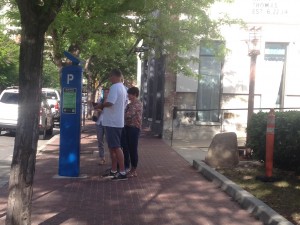 For the past two years, Utah Stories has covered the controversy surrounding Salt Lake City’s installation of Siemens solar paneled big blue parking meters. City council members were suckered by a smooth sales pitch telling them that these new meters would be the answer to the projected parking revenue shortfall, which was identified as over $4 million per year, compared with similar-sized cities.
For the past two years, Utah Stories has covered the controversy surrounding Salt Lake City’s installation of Siemens solar paneled big blue parking meters. City council members were suckered by a smooth sales pitch telling them that these new meters would be the answer to the projected parking revenue shortfall, which was identified as over $4 million per year, compared with similar-sized cities.
Becker saw these meters as the cure to revenue shortfalls. A $50,000 study conducted in 2009, informed the administration that Salt Lake City drivers were, in essence. ripping the city off, that parking should be more expensive and it should be more strictly enforced.
Thee blue meters, costing around $7 million, were supposedly the answer. The lesson learned now two years later should be: don’t believe all the experts, especially those who make commerce more difficult for local business owners. Businesses lose customers who avoid downtown parking hassles, and also lose them to City Creek Center, which offers free one-hour and validated garage parking.
Our follow up story last year later showed that residents, business owners and visitors to Salt Lake City predominantly were not fans of the new meters. For example, when visitors simultaneously converged on downtown for a planned event, lines formed at the single meter that served several parking spaces. It took only one person’s confusion to turn into a group’s impatience and frustration. Remembering the stall number, typing it into the keypad, then wondering how to add time, and whether the receipt needed to be placed on the dashboard were all common frustrations.
As it turned out, the city has realized an over $1.5 million loss last year on their sizable investment. One might expect that the increase in parking fees and extending of paid parking hours would have doubled city revenue. Instead, they realized a huge loss. How could this happen?
It turns out, one party’s loss is another party’s gain. It is logical to assume that now more people are parking in parking lots and garages than ever before. More residents are biking downtown to see concerts. More are riding Trax into downtown. Average weekday ridership increased from 60,592 in 2012 to 69,600 in 2013. Now more shoppers and diners are planning their entire downtown trips around City Creek Center. Taubman Partner’s should thank Mayor Becker for ensuring the success of their new center, which is 95 percent corporate chains.
The locally owned businesses near City Creek Center are not faring as well. Two restaurants, which opened in anticipation of the opening of the City Creek Center, have chosen to relocate. Braza Express moved to downtown Provo, which offers free parking, and has found success. Bayleaf rebranded and moved to Sugar House, reopening as Campfire Lounge. Cinegrill Restaurant is relocating from their long-time location (since 1946) because of customer loss directly related to the parking meters. They are relocating to a shopping center with free parking at 1000 South Main. The Manhattan Finds boutique has also departed, and a walk down the street reveals many vacant storefronts. So, in essence, the meters have been great for City Creek and suburban shopping centers, but bad for Main Street and the locally owned downtown element.
There is, however, a slight glimmer of hope on the horizon. Recently, three plaintiffs filed a lawsuit against Salt Lake City regarding the electronic parking meters. Their claim is that the city code was never revised to accommodate the procedural changes to the meters. The lawsuit seeks a refund of all parking-ticket revenue, court fees and collection costs, plus interest and a halt to parking-meter violations until the code is updated. The council has recently updated the code.
So, as it has been for the past 40 years in downtown Salt Lake City, with the exception of the Rocky Anderson administration, city leaders are doing a lot of good for corporate America, and a lot of bad for locally owned businesses.





